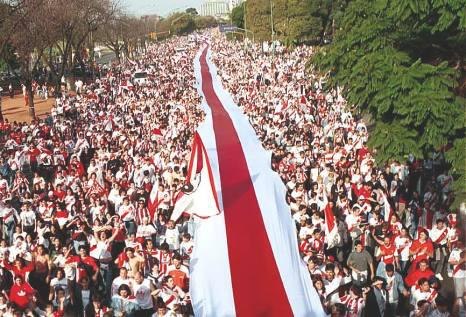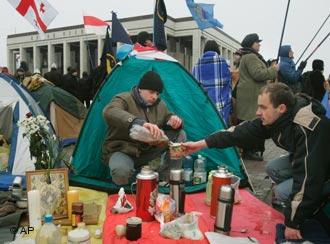Why Don’t Belarusians Revolt?

Over the last fifteen years Belarusians have become used to the authorities' brutality during opposition demonstrations. Since 19 December 2010 the police have been particularly repressive, leaving no opportunities for protesters. But the massive rally in Minsk on 25 March, Freedom Day, was unexpectedly peaceful.
The police behaved in an unusually friendly manner. This led some commentators to conclude that a new political thaw might be beginning in Belarus. Unfortunately, such a conclusion looks groundless. The Belarusian regime sees the prospect of massive protests as a major threat to its power. Therefore it will take every possible step, including harsh repression, to prevent any form of revolution.
The Roots of Fear of Street Democracy
The authorities' fear of street democracy originates in memories of the 1990s, when tens of thousands regularly went to the streets to protest.
Massive demonstrations began at the end of the 1980s and grew larger in the first half of the 1990s. Belarusians protested primarily against the government's economic policies. Interestingly, at that time the authorities treated demonstrators with tolerance. According to the authors of the book Baptising the Nation police only used force and dispersed a street protest on only one occasion between 1988 and 1990.
In 1991 Belarus saw the largest street rallies in its history. The workers of the majority of Minsk factories went on strike because of rising prices and falling living standards. On 4 April 1991 the biggest demonstration ever occurred with between 50,000 and 100,000 protesters gathering in the centre of Minsk. Large rallies also took place across the whole country.
 In 1992-1995 the protests significantly subsided. The level of police violence against demonstrators remained low. But after Alexander Lukashenka was elected president in July 1994 the government took a very aggressive stance on all forms of mass discontent.
In 1992-1995 the protests significantly subsided. The level of police violence against demonstrators remained low. But after Alexander Lukashenka was elected president in July 1994 the government took a very aggressive stance on all forms of mass discontent.
The year of 1996 saw a wave of massive street protests. They were caused by the developments to the government’s domestic and foreign policies. The most notable of these were the signing of the Commonwealth Treaty with Russia (2 April 1996) and Chernobyl Day protest (26 April 1996). Authorities dispersed the protests with extreme brutality.
Authoritarian Grip on Street Activism
Following the constitutional changes in November 1996, the Belarusian political system turned authoritarian. The government started to severely limit all political freedoms. It did not allow most of street demonstrations and then brutally dispersed "unsanctioned" ones.
The authorities began to apply a wide range of repressive measures against the participants of street actions. Besides brutal physical force, they include fines and administrative arrests. Universities started to expel students who participated in street action. The government also began to force employers to dismiss their employees who were noticed at opposition demonstrations. Although the vast majority of protesters remain in their jobs and at universities, the fear of being dismissed works as a strong deterrent. Because of the poor economic conditions in the country, finding a new job could be a very difficult task.
As a result of the government's repression, the number of participants of demonstrations started to drop significantly. Opposition street events turned into mainly political rituals that did not have country-wide resonance. It became too risky for common Belarusians to sacrifice not only their physical wellbeing but also sources of stable income for their families.
Renaissance of Street Democracy
The euphoric victory of the “Orange Revolution” in Ukraine impressed many Belarusians. They hoped that the 2006 presidential election would provide an opportunity for a similar scenario in Belarus.
Between 15,000 and 25,000 people took to the streets following what was seen as a rigged election in March 2006. An opposition tent camp popped up in the central square of Minsk as a sign of the protesters’ determination to fight for their rights.
The camp survived for a week and became a symbol of youth resistance against the authoritarian state. In the end the police stormed the tent camp and arrested several hundreds of young protesters. Dozens of demonstrators were later expelled from universities or were sacked from their jobs.
Four years later during the 2010 presidential campaign, a real renaissance of street democracy took place. Following the rapprochement with the West, the Belarusian authorities were trying to create a picture of political liberalisation during the campaign. They allowed open air gatherings of the candidates’ teams with their supporters and some forms of previously banned street agitation.
Unfortunately, that renaissance was brutally terminated by the crackdown on the election night. The riot police dispersed a demonstration which gathered around 30,000 on a cold December night. They arrested hundreds of the participants, including most of the presidential candidates (two of whom still remain in prison). A wave of repression against the opposition and civil society followed. However, only very few demonstrators were sacked or removed from their jobs this time.
The Regime Will Not Allow Street Democracy Again
After the peaceful demonstration on 25 March some commentators rushed to assume that the authorities might have started lowering the degree of repression in the country. Unfortunately, it does not look to be the case.
Several factors could explain the authorities’ tolerance towards the latest demonstration. First, the protest organisers agreed to follow the route that had been approved by the city council far from the city centre. Second, it was evident that the celebration of Freedom Day would not gather that many demonstrators. Third, the lack of unity among the opposition could hardly turn the demonstration into something threatening to the government. The result of the repression which followed the 2010 presidential elections was devastating for the opposition, which can no longer effectively mobilise its supporters.
The authorities could also have used the 25 March demonstration to signal to the EU that they can be flexible in their treatment of the opposition. Finally, in the Belarusian authoritarian system it is important for the government to “measure” the opposition’s street potential from time to time. That helps them understand the trends and see whether there are any new leaders.
But there is little reason to expect that this tolerance will continue. Even if the authorities decide to end the current conflict with the EU they are unlikely to soften their grip on the opposition. The 2010 presidential campaign was taken on board: tolerance to opposition street activities can undermine the government’s control of the situation. And that is what they fear most of all.
And the majority of Belarusians still fear revolting because of potential government repression. The risks of protesting for average Belarusians are high, while the probability that their protest will change anything remains, at best, uncertain.





